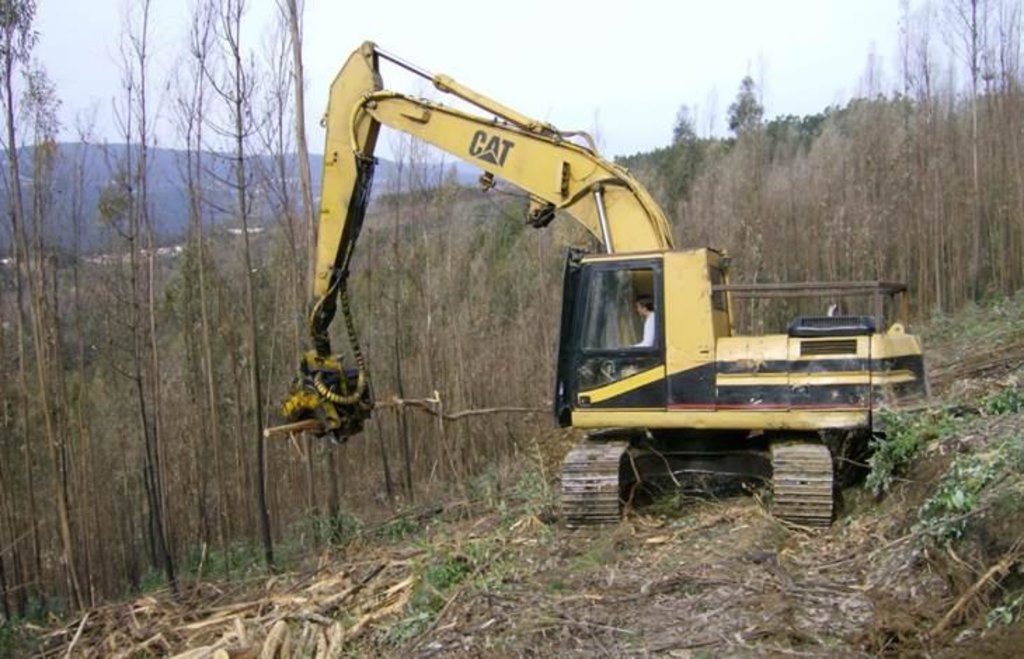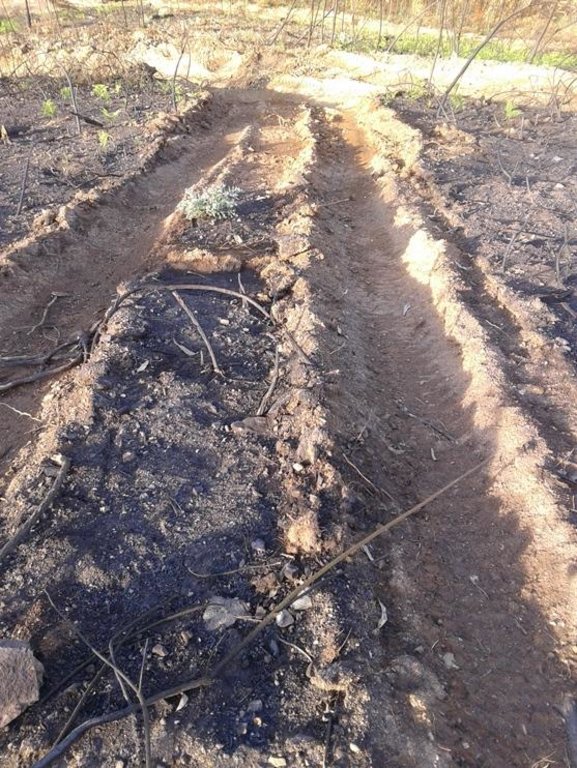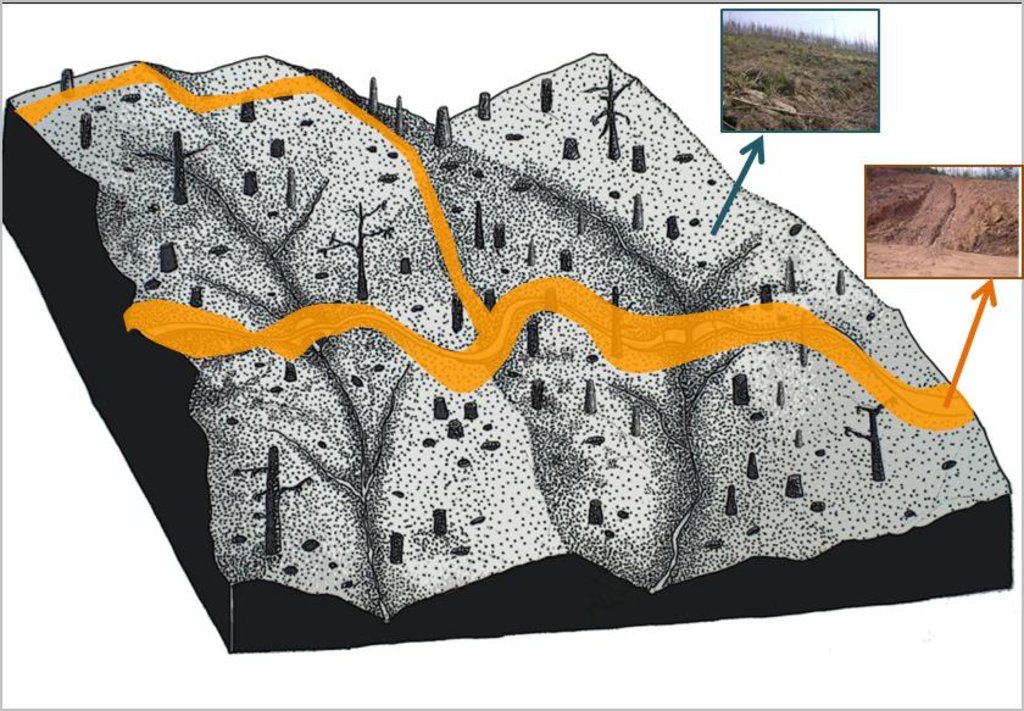Post-fire salvage logging; post-fire traditional logging [โปรตุเกส]
- ผู้สร้างสรรค์:
- การอัพเดท:
- ผู้รวบรวม: Maruxa Malvar Cortizo
- ผู้เรียบเรียง: –
- ผู้ตรวจสอบ: Fabian Ottiger
Extração material lenhoso pos-incêndio
technologies_1713 - โปรตุเกส
ดูส่วนย่อย
ขยายทั้งหมด ย่อทั้งหมด1. ข้อมูลทั่วไป
1.2 รายละเอียดที่ติดต่อได้ของผู้รวบรวมและองค์กรที่เกี่ยวข้องในการประเมินและการจัดเตรียมทำเอกสารของเทคโนโลยี
ผู้เชี่ยวชาญ SLM:
ผู้เชี่ยวชาญ SLM:
ผู้เชี่ยวชาญ SLM:
Keizer Jan Jacob
+ 351 234 370200
jjkeizer@ua.pt.
Centre for Environmental and Marine Studies (CESAM) - Department of Environment and Planning-University of Aveiro
Campus de Santiago, 3810-193 Aveiro, Portugal
โปรตุเกส
ชื่อขององค์กรซึ่งอำนวยความสะดวกในการทำเอกสารหรือการประเมินเทคโนโลยี (ถ้าเกี่ยวข้อง)
University of Aveiro (University of Aveiro) - โปรตุเกส1.3 เงื่อนไขการใช้ข้อมูลที่ได้บันทึกผ่านทาง WOCAT
วันที่เก็บรวบรวมข้อมูล(ภาคสนาม) :
21/09/2016
ผู้รวบรวมและวิทยากรหลักยอมรับเงื่อนไขเกี่ยวกับการใช้ข้อมูลที่ถูกบันทึกผ่านทาง WOCAT:
ใช่
2. การอธิบายลักษณะของเทคโนโลยี SLM
2.1 การอธิบายแบบสั้น ๆ ของเทคโนโลยี
คำจำกัดความของเทคโนโลยี:
Post-fire salvage logging is the practice of harvest the trees after fire, the employed methodology is clearcutting which involves the cut of essentially all the trees and the removal of logging residues.
2.2 การอธิบายแบบละเอียดของเทคโนโลยี
คำอธิบาย:
In the 2015 summer a wildfire affected the Semide mountain range nearby the Lousã massif, central Portugal. The area was afforested with eucalypt and pine plantations during last XX century and nowadays landscape is composed mainly by eucalypts at different stages of development and, the understory shrub vegetation.
The research team of the University of Aveiro set up an experiment to test the effect of post-fire logging in soil erosion and other selected soil properties.
Purpose of the Technology: Post-fire logging is a common management practice usually undertaken to recover burnt timber resources, to plant new seedlings and to reduce possible insect infestation hazard. In Portugal, about 10x106 m3 of timber could be harvested every year and a considerable percentage of this figure comes from recently burned eucalypt and pine stands.
Post-fire logging could have a multiple detrimental effect on ecosystem as fire-affected ecosystems are sensitive to further disturbance. This multiplier effect concerns soil compaction, soil (fertility) losses, with serious implications for in-situ plant growth, soil biota and for downstream aquatic systems. Furthermore, post-fire logging undermines the effectiveness of costly rehabilitation efforts aimed at reducing soil erosion. Hence, the post-fire logging practice is still controversial in terms of economic benefit and environmental consequences, in many parts of the world.
Establishment / maintenance activities and inputs: The standard logging technique consists of felling burned trees either with a harvester or manually with a chainsaw depending on slope conditions and machinery available. The logs will be gathered with the harvester, using a cable-skidder or pulling logs down-slope with a cable attached to a tractor. A forwarder will transport them to the main pile prior to load and removal by trucks.
The slope will present two well differenced units according to soil surface disturbance, the skid trail or the logged area.
Natural / human environment: The eucalypt trees in the region are typically planted as monocultures for paper pulp production, and harvested every 7-14 years. The landscape reflects a long history of intense land management, with a mosaic of (semi-)natural and man-made agricultural and afforested lands. Since the 1980´s, however, wildfires have increased dramatically in frequency and extent, aided by a general warming and drying trend but driven primarily by socio-economic changes.
2.3 รูปภาพของเทคโนโลยี
2.5 ประเทศภูมิภาค หรือสถานที่ตั้งที่เทคโนโลยีได้นำไปใช้และได้รับการครอบคลุมโดยการประเมินนี้
ประเทศ:
โปรตุเกส
ภูมิภาค/รัฐ/จังหวัด:
Coimbra
ข้อมูลจำเพาะเพิ่มเติมของสถานที่ตั้ง :
Coimbra
2.6 วันที่การดำเนินการ
ถ้าไม่รู้ปีที่แน่นอน ให้ระบุวันที่โดยประมาณ:
- มากกว่า 50 ปี (แบบดั้งเดิม)
2.7 คำแนะนำของเทคโนโลยี
ให้ระบุว่าเทคโนโลยีถูกแนะนำเข้ามาอย่างไร:
- เป็นส่วนหนึ่งของระบบแบบดั้งเดิมที่ทำก้นอยู่ (> 50 ปี)
3. การจัดประเภทของเทคโนโลยี SLM
3.2 ประเภทของการใช้ที่ดินในปัจจุบันที่ได้นำเทคโนโลยีไปใช้

ป่า/พื้นที่ทำไม้
ผลิตภัณฑ์และบริการ:
- ไม้ซุง
- ไม้ที่นำมาทำเป็นเชื้อเพลิง
แสดงความคิดเห็น:
Major land use problems (compiler’s opinion): Strong increases in runoff and erosion should be a main land management concern following wildfires, as they constitute a serious threat to land-use sustainability and downstream aquatic habitats and human infrastructures. In addition to fire itself, post-fire logging activities can greatly increase erosion response of recently burnt areas. Furthermore, logging is typically the most common practice after fire, and recently burnt soils are more erodible than long-unburnt soils.
Major land use problems (land users’ perception): Loss of wood resources and productivity.
Plantation forestry: Yes
Forest products and services: timber, fuelwood
3.3 ข้อมูลเพิ่มเติมเกี่ยวกับการใช้ที่ดิน
จำนวนของฤดูเพาะปลูกต่อปี:
- 3
ระบุ:
Longest growing period in days: 270Longest growing period from month to month: September to May
3.4 กลุ่ม SLM ที่ตรงกับเทคโนโลยีนี้
- การจัดการป่าธรรมชาติและกึ่งธรรมชาติ
- การจัดการสวนป่า
- Post-fire logging
3.5 กระจายตัวของเทคโนโลยี
ระบุการกระจายตัวของเทคโนโลยี:
- กระจายไปอย่างสม่ำเสมอในพื้นที่
ถ้าหากว่าเทคโนโลยีได้มีการกระจายออกไปอย่างสม่ำเสมอในพื้นที่ ให้ระบุปริมาณพื้นที่ที่ได้รับการครอบคลุมถึง:
- < 0.1 ตร.กม.(10 เฮกตาร์)
แสดงความคิดเห็น:
The studied area is a hillslope scale but total logged area is larger
3.6 มาตรการ SLM ที่ประกอบกันเป็นเทคโนโลยี

มาตรการจัดการพืช
- A1: พืช/สิ่งปกคลุมดิน

มาตรการอนุรักษ์ด้วยวิธีพืช
- V3: กำจัดพืชออกให้หมด

มาตรการอนุรักษ์ด้วยการจัดการ
- M7: อื่นๆ
แสดงความคิดเห็น:
Main measures: management measures
Specification of other management measures: Recover burnt timber resources and improve the re-sprout of new eucalypts
3.7 รูปแบบหลักของการเสื่อมโทรมของที่ดินที่ได้รับการแก้ไขโดยเทคโนโลยี

การกัดกร่อนของดินโดยน้ำ
- Wt (Loss of topsoil): การสูญเสียดินชั้นบนหรือการกัดกร่อนที่ผิวดิน

การเสื่อมโทรมของดินทางด้านกายภาพ
- Pc (Compaction): การอัดแน่น

การเสื่อมโทรมของดินทางด้านชีวภาพ
- Bc (Reduction of vegetation cover): การลดลงของจำนวนพืชที่ปกคลุมดิน
- Bf (Detrimenta leffects of fires): ผลเสียหายจากไฟ
แสดงความคิดเห็น:
Main type of degradation addressed: Wt: loss of topsoil / surface erosion, Pc: compaction, Bc: reduction of vegetation cover, Bf: detrimental effects of fires
Main causes of degradation: soil management (Eucalypt plantations are prone to forest fires), crop management (annual, perennial, tree/shrub) (Logging increases soil erosin risk and soil compactation), deforestation / removal of natural vegetation (incl. forest fires) (Logging increases the lost of vegetation cover), population pressure (Since the 1980´s, eucalypt plantations increased greatly, driven primarily by socio-economic changes.)
3.8 การป้องกัน การลดลง หรือการฟื้นฟูความเสื่อมโทรมของที่ดิน
ระบุเป้าหมายของเทคโนโลยีกับความเสื่อมโทรมของที่ดิน:
- ลดความเสื่อมโทรมของดิน
แสดงความคิดเห็น:
Secondary goals: mitigation / reduction of land degradation
4. ข้อมูลจำเพาะด้านเทคนิค กิจกรรมการนำไปปฏิบัติใช้ ปัจจัยนำเข้า และค่าใช้จ่าย
4.1 แบบแปลนทางเทคนิคของเทคโนโลยี
4.2 ข้อมูลจำเพาะด้านเทคนิคและการอธิบายแบบแปลนทางเทคนิค
The slope will present two well differentiated units according to soil surface disturbance, the machinery trail and the logged area. The soil erosion risk will be associated with the loss of ground cover due to mechanical disturbance. Furthermore, the machinery trail presents the risk of concentrated overland-flow with the subsequent rill formation.
Location: Semide. Coimbra
Technical knowledge required for field staff / advisors: low
Technical knowledge required for land users: low (The use of machinery is preferable but not essential)
Main technical functions: control of dispersed runoff: retain / trap, control of concentrated runoff: impede / retard, improvement of ground cover, improvement of surface structure (crusting, sealing), sediment retention / trapping, sediment harvesting
Secondary technical functions: control of raindrop splash, improvement of subsoil structure (hardpan)
Other type of management: Recover burnt timber resources and improve the re-sprout of eucalypt stumps
4.3 ข้อมูลทั่วไปเกี่ยวกับการคำนวณปัจจัยนำเข้าและค่าใช้จ่าย
อื่นๆ หรือสกุลเงินประจำชาติ (ระบุ):
euros
ระบุอัตราแลกเปลี่ยนจากดอลลาร์สหรัฐเป็นสกุลเงินท้องถิ่น (ถ้าเกี่ยวข้อง) คือ 1 เหรียญสหรัฐ =:
0.92
ระบุค่าเฉลี่ยของค่าจ้างในการจ้างแรงงานต่อวัน:
60.87
4.4 กิจกรรมเพื่อการจัดตั้ง
| กิจกรรม | ประเภทของมาตรการ | ช่วงเวลาดำเนินการ | |
|---|---|---|---|
| 1. | 1 person with chainsaw | ด้วยการจัดการ | 24 |
| 2. | Harvester transport ( in a radio of 50 km)Harvester working (with person)Forwarder (with person)Final transport (in a radio of 50 km) | ด้วยการจัดการ | 60 |
4.5 ค่าใช้จ่ายของปัจจัยนำเข้าที่จำเป็นสำหรับการจัดตั้ง
| ปัจจัยนำเข้า | หน่วย | ปริมาณ | ค่าใช้จ่ายต่อหน่วย | ค่าใช้จ่ายทั้งหมดต่อปัจจัยนำเข้า | %ของค่าใช้จ่ายที่ก่อให้เกิดขึ้นโดยผู้ใช้ที่ดิน | |
|---|---|---|---|---|---|---|
| แรงงาน | Labour | ha | 1.0 | 1461.0 | 1461.0 | |
| อุปกรณ์ | Machine use | ha | 1.0 | 5870.0 | 5870.0 | |
| ค่าใช้จ่ายทั้งหมดของการจัดตั้งเทคโนโลยี | 7331.0 | |||||
4.7 ค่าใช้จ่ายของปัจจัยนำเข้าและกิจกรรมที่เกิดขึ้นเป็นประจำที่ต้องการการบำรุงรักษา (ต่อปี)
แสดงความคิดเห็น:
The prices were determined for a clearcutting of a slope with acceptable slope degree and accessibility. Prices were calculated by hectare in winter 2015 for central Portugal.
4.8 ปัจจัยสำคัญที่สุดที่มีผลกระทบต่อค่าใช้จ่าย
ปัจจัยสำคัญที่สุดที่มีผลกระทบต่อค่าใช้จ่ายต่างๆ:
Accessibility and steepness will raise the costs. The use of machinery is not a mandatory. Small land owners decrease the total cost by doing manual work with a family framework.
5. สิ่งแวดล้อมทางธรรมชาติและของมนุษย์
5.1 ภูมิอากาศ
ฝนประจำปี
- < 250 ม.ม.
- 251-500 ม.ม.
- 501-750 ม.ม.
- 751-1,000 ม.ม.
- 1,001-1,500 ม.ม.
- 1,501-2,000 ม.ม.
- 2,001-3,000 ม.ม.
- 3,001-4,000 ม.ม.
- > 4,000 ม.ม.
เขตภูมิอากาศเกษตร
- ชื้น
- กึ่งชุ่มชื้น
Thermal climate class: subtropics
Thermal climate class: temperate
5.2 สภาพภูมิประเทศ
ค่าเฉลี่ยความลาดชัน:
- ราบเรียบ (0-2%)
- ลาดที่ไม่ชัน (3-5%)
- ปานกลาง (6-10%)
- เป็นลูกคลื่น (11-15%)
- เป็นเนิน (16-30%)
- ชัน (31-60%)
- ชันมาก (>60%)
ธรณีสัณฐาน:
- ที่ราบสูง/ที่ราบ
- สันเขา
- ไหล่เขา
- ไหล่เนินเขา
- ตีนเนิน
- หุบเขา
ระดับความสูง:
- 0-100 เมตร
- 101-500 เมตร
- 501-1,000 เมตร
- 1,001-1,500 เมตร
- 1,501-2,000 เมตร
- 2,001-2,500 เมตร
- 2,501-3,000 เมตร
- 3,001-4,000 เมตร
- > 4,000 เมตร
5.3 ดิน
ค่าเฉลี่ยความลึกของดิน:
- ตื้นมาก (0-20 ซ.ม.)
- ตื้น (21-50 ซ.ม.)
- ลึกปานกลาง (51-80 ซ.ม.)
- ลึก (81-120 ซ.ม.)
- ลึกมาก (>120 ซ.ม.)
เนื้อดิน (ดินชั้นบน):
- หยาบ/เบา (ดินทราย)
- ปานกลาง (ดินร่วน ทรายแป้ง)
อินทรียวัตถุในดิน:
- สูง (>3%)
(ถ้ามี) ให้แนบคำอธิบายเรื่องดินแบบเต็มหรือระบุข้อมูลที่มีอยู่ เช่น ชนิดของดิน ค่า pH ของดินหรือความเป็นกรดของดิน ความสามารถในการแลกเปลี่ยนประจุบวก ไนโตรเจน ความเค็ม เป็นต้น:
Soil fertility is medium-high
Topsoil organic matter is high (afforested soils)
Soil drainage/infiltration is poor-medium ( Soil water repellency)
Soil water storage capacity is low (very shallow soils)
5.4 ความเป็นประโยชน์และคุณภาพของน้ำ
ระดับน้ำใต้ดิน:
5-50 เมตร
น้ำไหลบ่าที่ผิวดิน:
ดี
คุณภาพน้ำ (ที่ยังไม่ได้บำบัด):
เป็นน้ำเพื่อการดื่มที่ดี
ความคิดเห็นและข้อมูลจำเพาะเพิ่มเติมเรื่องคุณภาพและปริมาณน้ำ:
Availability of surface water is good - medium (very dry summer)
5.5 ความหลากหลายทางชีวภาพ
ความหลากหลายทางชนิดพันธุ์:
- ต่ำ
ความคิดเห็นและข้อมูลจำเพาะเพิ่มเติมของความหลากหลายทางชีวภาพ:
Burnt soil
5.6 ลักษณะของผู้ใช้ที่ดินที่นำเทคโนโลยีไปปฏิบัติใช้
แนวทางการตลาดของระบบการผลิต:
- ผสม (การเลี้ยงชีพ/ทำการค้า)
- ทำการค้า/การตลาด
รายได้ที่มาจากนอกฟาร์ม:
- 10-50% ของรายได้ทั้งหมด
ระดับของความมั่งคั่งโดยเปรียบเทียบ:
- จน
- พอมีพอกิน
เป็นรายบุคคล/ครัวเรือน:
- เป็นรายบุคคล/ครัวเรือน
เพศ:
- ชาย
ระบุลักษณะอื่นๆที่เกี่ยวข้องของผู้ใช้ที่ดิน:
Land users applying the Technology are mainly common / average land users
Difference in the involvement of women and men: Harvesting forest areas is typically a men work, probably due to the machinery use and/or the physical strength needed.
Population density: 50-100 persons/km2
Annual population growth: < 0.5%
Market orientation of production system: subsistence (self-supply), mixed (subsistence/ commercial, commercial/ market
5.7 พื้นที่เฉลี่ยของที่ดินที่เป็นเจ้าของหรือเช่าโดยผู้ใช้ที่ดินที่นำเทคโนโลยีไปปฏิบัติใช้
- < 0.5 เฮกตาร์
- 0.5-1 เฮกตาร์
- 1-2 เฮกตาร์
- 2-5 เฮกตาร์
- 5-15 เฮกตาร์
- 15-50 เฮกตาร์
- 50-100 เฮกตาร์
- 100-500 เฮกตาร์
- 500-1,000 เฮกตาร์
- 1,000-10,000 เฮกตาร์
- >10,000 เฮกตาร์
พิจารณาว่าเป็นขนาดเล็ก กลาง หรือขนาดใหญ่ (ซึ่งอ้างอิงถึงบริบทระดับท้องถิ่น):
- ขนาดเล็ก
แสดงความคิดเห็น:
Average area of land owned or leased by land users applying the Technology: 2-5 ha, 5-15 ha, 15-50 ha
5.8 กรรมสิทธิ์ในที่ดิน สิทธิในการใช้ที่ดินและสิทธิในการใช้น้ำ
กรรมสิทธิ์ในที่ดิน:
- รายบุคคล ไม่ได้รับสิทธิครอบครอง
สิทธิในการใช้น้ำ:
- เกี่ยวกับชุมชน (ถูกจัดระเบียบ)
5.9 การเข้าถึงบริการและโครงสร้างพื้นฐาน
สุขภาพ:
- จน
- ปานกลาง
- ดี
การศึกษา:
- จน
- ปานกลาง
- ดี
ความช่วยเหลือทางด้านเทคนิค:
- จน
- ปานกลาง
- ดี
การจ้างงาน (เช่น ภายนอกฟาร์ม):
- จน
- ปานกลาง
- ดี
ตลาด:
- จน
- ปานกลาง
- ดี
พลังงาน:
- จน
- ปานกลาง
- ดี
ถนนและการขนส่ง:
- จน
- ปานกลาง
- ดี
น้ำดื่มและการสุขาภิบาล:
- จน
- ปานกลาง
- ดี
บริการด้านการเงิน:
- จน
- ปานกลาง
- ดี
6. ผลกระทบและสรุปคำบอกกล่าว
6.1 ผลกระทบในพื้นที่ดำเนินการ (On-site) จากการใช้เทคโนโลยี
ผลกระทบทางด้านเศรษฐกิจและสังคม
การผลิต
การผลิตไม้
ความหลากหลายของผลิตภัณฑ์
แสดงความคิดเห็น/ระบุ:
Promoves eucalypt monocultures
การผลิตพลังงาน
แสดงความคิดเห็น/ระบุ:
Biomass
รายได้และค่าใช้จ่าย
ความหลากหลายของแหล่งผลิตรายได้
ผลกระทบด้านสังคมวัฒนธรรมอื่น ๆ
โอกาสทางด้านสันทนาการ
แสดงความคิดเห็น/ระบุ:
The logging of the burnt trunks arguably improves the esthetic value of the area, including by removing evidence of the fire
Improved livelihoods and human well-being
แสดงความคิดเห็น/ระบุ:
Yes, because timber production is a complementary income for many families in the region
ผลกระทบด้านนิเวศวิทยา
วัฐจักรน้ำหรือน้ำบ่า
คุณภาพน้ำ
น้ำไหลบ่าที่ผิวดิน
การระเหย
ดิน
ความชื้นในดิน
สิ่งปกคลุมดิน
การเกิดแผ่นแข็งที่ผิวดิน /การเกิดชั้นดาน
การอัดแน่นของดิน
อินทรียวัตถุในดิน/ต่ำกว่าดินชั้น C
ความหลากหลายทางชีวภาพของพืชและสัตว์
การจัดการศัตรูพืชและโรคพืช
ลดความเสี่ยงของภัยพิบัติ
ความเสี่ยงจากไฟ
ความเร็วของลม
ผลกระทบด้านนิเวศวิทยาอื่น ๆ
Soil erosion locally
Crop diversity
Habitat fragmentation
6.2 ผลกระทบนอกพื้นที่ดำเนินการ (Off-site) จากการใช้เทคโนโลยี
การไหลของน้ำคงที่และสม่ำเสมอในช่วงฤดูแล้ง
น้ำท่วมพื้นที่ท้ายน้ำ
การทับถมของดินตะกอนพื้นที่ท้ายน้ำ
การเกิดมลพิษในน้ำบาดาลหรือแม่น้ำ
ความสามารถต้านทานการเปลี่ยนแปลง / ความสามารถในการคัดกรอง
ความเสียหายต่อพื้นที่เพาะปลูกของเพื่อนบ้าน
ความเสียหายต่อโครงสร้างพื้นฐานของรัฐหรือของเอกชน
6.3 การเผชิญและความตอบสนองของเทคโนโลยีต่อการเปลี่ยนแปลงสภาพภูมิอากาศที่ค่อยเป็นค่อยไป และสภาพรุนแรงของภูมิอากาศ / ภัยพิบัติ (ที่รับรู้ได้โดยผู้ใช้ที่ดิน)
การเปลี่ยนแปลงสภาพภูมิอากาศที่ค่อยเป็นค่อยไป
การเปลี่ยนแปลงสภาพภูมิอากาศที่ค่อยเป็นค่อยไป
| ฤดู | ประเภทของการเปลี่ยนแปลงสภาพภูมิอากาศที่ค่อยเป็นค่อยไป และสภาพรุนแรงของภูมิอากาศ | เทคโนโลยีมีวิธีการรับมืออย่างไร | |
|---|---|---|---|
| อุณหภูมิประจำปี | เพิ่มขึ้น | ดี |
สภาพรุนแรงของภูมิอากาศ (ภัยพิบัติ)
ภัยพิบัติทางอุตุนิยมวิทยา
| เทคโนโลยีมีวิธีการรับมืออย่างไร | |
|---|---|
| พายุฝนประจำท้องถิ่น | ไม่ค่อยดี |
| พายุลมประจำท้องถิ่น | ดี |
ภัยพิบัติจากสภาพภูมิอากาศ
| เทคโนโลยีมีวิธีการรับมืออย่างไร | |
|---|---|
| ภัยจากฝนแล้ง | ไม่ค่อยดี |
ภัยพิบัติจากน้ำ
| เทคโนโลยีมีวิธีการรับมืออย่างไร | |
|---|---|
| น้ำท่วมตามปกติ (แม่น้ำ) | ดี |
ผลลัพธ์ตามมาที่เกี่ยวข้องกับภูมิอากาศอื่น ๆ
ผลลัพธ์ตามมาที่เกี่ยวข้องกับภูมิอากาศอื่น ๆ
| เทคโนโลยีมีวิธีการรับมืออย่างไร | |
|---|---|
| ช่วงการปลูกพืชที่ลดลงมา | ไม่ค่อยดี |
6.4 การวิเคราะห์ค่าใช้จ่ายและผลประโยชน์ที่ได้รับ
ผลประโยชน์ที่ได้รับเปรียบเทียบกับค่าใช้จ่ายในการจัดตั้งเป็นอย่างไร (จากมุมมองของผู้ใช้ที่ดิน)
ผลตอบแทนระยะสั้น:
ด้านบวกเล็กน้อย
ผลตอบแทนระยะยาว:
ด้านบวก
แสดงความคิดเห็น:
There is no maintenance
6.5 การปรับตัวของเทคโนโลยี
แสดงความคิดเห็น:
100% of land user families have adopted the Technology without any external material support
Comments on spontaneous adoption: Small land owners need to request the clearcutting to harvester companies; but they do it spontaneus
6.7 จุดแข็ง / ข้อได้เปรียบ / โอกาสของเทคโนโลยี
| จุดแข็ง / ข้อได้เปรียบ / โอกาสในทัศนคติของผู้ใช้ที่ดิน |
|---|
|
Short-term economic benefits How can they be sustained / enhanced? Decrease wildfires will increase the economic value of the timber |
| จุดแข็ง / ข้อได้เปรียบ / โอกาสในทัศนคติของผู้รวบรวมหรือวิทยากรหลัก |
|---|
|
The chance to obtain an economic benefit from forest plantations diminished depopulation of rural areas in the region. How can they be sustained / enhanced? A diversification toward native forest species cultivation (i.e. cork oak, olive trees, and chestnut tree) would be a very good alternative for the improvement of the ecosystem services, the reduction of wildfires risk and the increase of the socio-economic conditions in the region |
6.8 จุดอ่อน / ข้อเสียเปรียบ / ความเสี่ยงของเทคโนโลยีและวิธีการแก้ไข
| จุดอ่อน / ข้อเสียเปรียบ / ความเสี่ยงในทัศนคติของผู้ใช้ที่ดิน | มีวิธีการแก้ไขได้อย่างไร |
|---|---|
| When timber quality is no good (due to fire) there is no economic benefit | Take the advantage to modify eucalypt plantations toward more sustainable land use |
| จุดอ่อน / ข้อเสียเปรียบ / ความเสี่ยงในทัศนคติของผู้รวบรวมหรือวิทยากรหลัก | มีวิธีการแก้ไขได้อย่างไร |
|---|---|
| Increased runoff and soil erosion and possibly modify soil properties | There are several mitigation treatments that can be used to decrease the risk of soil erosion/degradation after logging activities. The use of water dams in the machinery trails and/or the spread of logging residues on the uncover/disturbed soil are techniques that can give good results |
7. การอ้างอิงและการเชื่อมต่อ
7.2 การอ้างอิงถึงสิ่งตีพิมพ์
หัวข้อ, ผู้เขียน, ปี, หมายเลข ISBN:
DellaSala, D.A., 2006. Post-fire Logging, Summary of Key Studies and Findings. World Wildlife Fund, Washington,USA.
http://www.nccsp.org/files/Postfire%20Summary%20of%20Key%20Findings.pdf
Fernández. C, J.A. Vega, Fonturbel.T Pérez-Gorostiaga P., Jiménez E., Madrigal.J., 2007. Effects of wildfire salvage logging and slash treatments on soil degradation. Land Degrad. Develop. 18: 591–607. DOI: 10.1002/ldr.797.
Inbar, M., Wittenberg, L., Tamir, M., 1997. Soil erosion and forestry management after wildfire in a Mediterranean woodland, Mt. Carmel, Israel. International Journal of Wildland Fire 7: 285–294.
Malvar, M.C., Martins, M.A.S., Nunes, J.P., Robichaud, P.R., Keizer, J.J., 2013. Assessing the role of pre-fire ground preparation operations and soil water repellency in post-fire runoff and inter-rill erosion by repeated rainfall simulation experiments in Portuguese eucalypt plantations. Catena, 108, 69-83.
Prats S.A., Malvar M.C., Vieira D.C.S., Keizer J.J., 2013, in press. Effectiveness of hydromulching to reduce runoff and erosion in a recently burnt and logged Maritime Pine stand in central Portugal. Land Degradation and Development. (accepted in June 2013).DOI: 10.1002/ldr.2236.
RECARE project: Preventing and Remediating degradation of soils in Europe trhough Land Care.
http://www.recare-project.eu/
ชื่อเรื่อง ผู้เขียน ปี ISBN:
internet
ลิงก์และโมดูล
ขยายทั้งหมด ย่อทั้งหมดลิงก์
ไม่มีลิงก์
โมดูล
ไม่มีโมดูล





